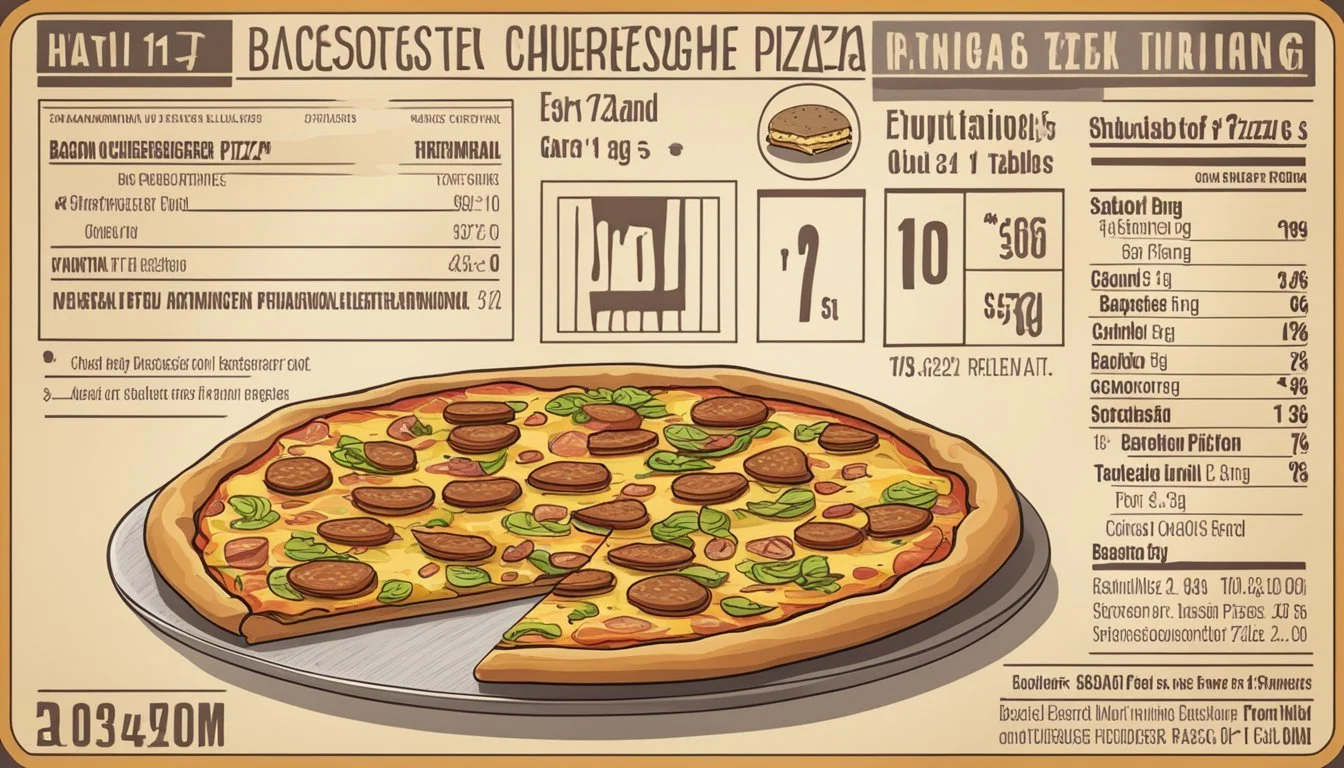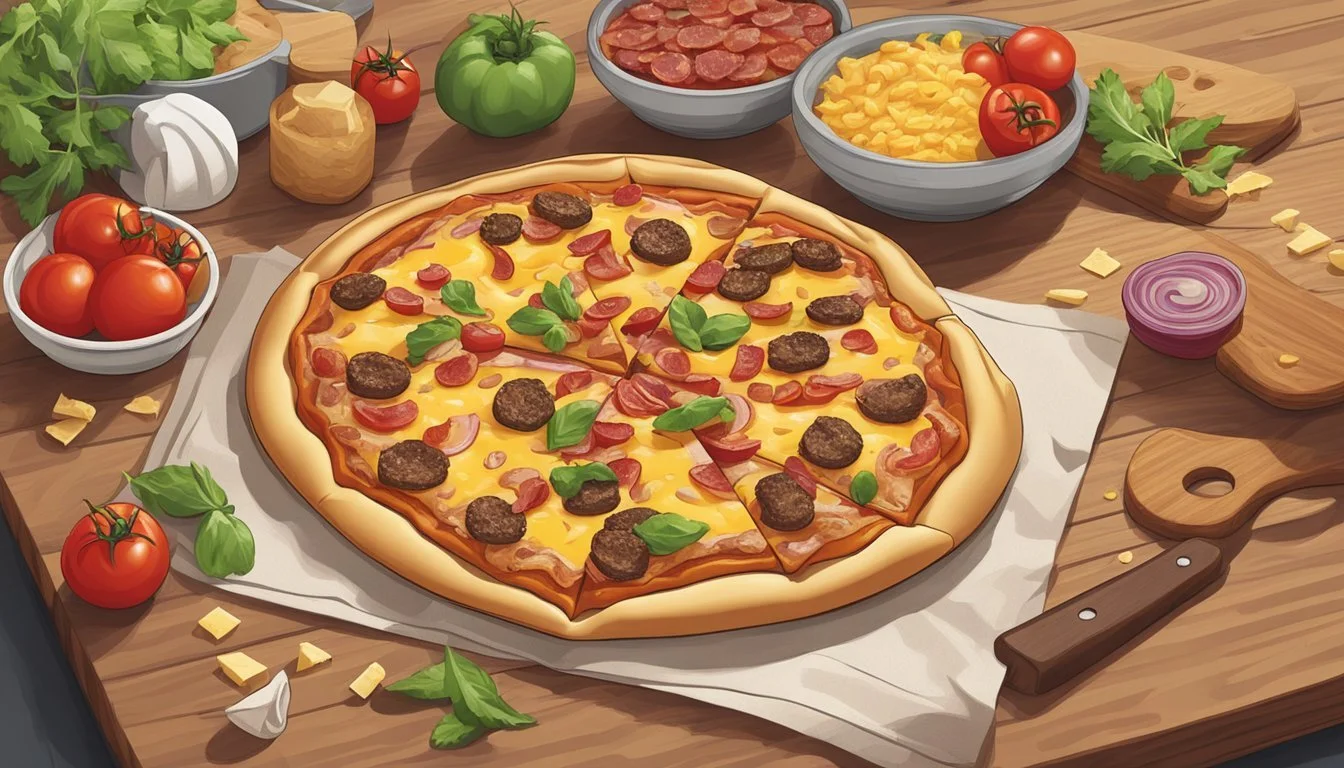How Long Does Bacon Cheeseburger Pizza Last?
Tips for Storage and Freshness
Bacon cheeseburger pizza blends the rich flavors of juicy beef, crispy bacon, and melty cheese atop a perfectly baked crust. While enjoying this delectable combination, it's crucial to know how long you can safely store it. A properly stored bacon cheeseburger pizza can last in the refrigerator for up to 3-4 days.
To maximize the shelf life, ensure the pizza is kept in an airtight container or tightly wrapped in plastic wrap or aluminum foil. Reheating it thoroughly before eating will also help maintain its taste and safety. Staying informed about storage times ensures you savor every bite without any worries.
Overview of Bacon Cheeseburger Pizza
Bacon cheeseburger pizza combines the beloved elements of a classic cheeseburger with the convenience and flavor profile of a pizza. This fusion dish offers a unique experience by blending familiar tastes in an unconventional format.
Understanding Bacon Cheeseburger Pizza Components
Dough: The base of any good pizza, including bacon cheeseburger pizza, is the dough. A well-risen dough creates the ideal crust that can support the various toppings and sauces.
Sauce: Unlike traditional pizza, which often uses tomato-based sauces, bacon cheeseburger pizza frequently incorporates ketchup, mustard, Thousand Island dressing, or a special burger sauce. This brings out the flavor of a cheeseburger.
Toppings: Key toppings include cooked ground beef, bacon, and pickles. The beef is usually browned and seasoned, while the bacon adds a savory, crispy texture. Pickles provide a tangy contrast.
Cheese: A mixture of cheddar or mozzarella is commonly used. This ensures a good melt and complements the burger toppings perfectly.
Comparing Bacon Cheeseburger Pizza to Traditional Pizzas
Sauces: Traditional pizzas often use marinara or other tomato-based sauces. In contrast, bacon cheeseburger pizza uses unconventional sauces like ketchup, mustard, and burger sauce to mimic the taste of a cheeseburger.
Toppings: Traditional pizza toppings include pepperoni, mushrooms, and bell peppers. In bacon cheeseburger pizza, the toppings reflect those found on a cheeseburger—ground beef, bacon, and pickles.
Flavor Profile: Traditional pizzas have a more Italian flavor due to ingredients like oregano, basil, and Parmesan. Bacon cheeseburger pizza leans towards American flavors, emphasizing savory, tangy, and slightly sweet notes. This results in a pizza that has a comforting, familiar taste of a cheeseburger.
Storage and Shelf Life
Proper storage is essential to keep a bacon cheeseburger pizza fresh and safe to eat. Knowing how to store it, determining its freshness, and following recommended shelf life guidelines will ensure the best quality.
Storage Best Practices
To maximize shelf life, store leftover bacon cheeseburger pizza in the refrigerator. Place it in an airtight container or wrap it tightly with aluminum foil or plastic wrap. Proper storage helps retain flavor and prevents contamination.
If you need a longer storage solution, consider freezing the pizza. Flash freezing individual slices before placing them in a freezer-safe bag will help maintain quality. Label the bag with the storage date to track its age and consumption safely.
Determining Freshness and Safety
Check for signs of spoilage before consuming leftover pizza. Look for unusual discoloration, off smells, or a change in texture. If the pizza appears dry or has an uncharacteristic odor, it's best to discard it. Mold or a slimy texture are definitive signs that the pizza should not be eaten.
Remember that high sodium content in bacon cheeseburger pizzas can act as a preservative to some extent. However, this does not replace the need for proper storage and regular safety checks.
Shelf Life Recommendations
Refrigerated, bacon cheeseburger pizza typically lasts for 3 to 4 days. If frozen, it can safely be stored for up to 1 to 2 months. It is important to note that while freezing extends shelf life, flavor and texture may deteriorate over time.
When planning to eat frozen leftovers, reheat to an internal temperature of 165°F (74°C) before consuming. This ensures that any potential bacteria are killed and the pizza is safe to eat. Total time from fridge to consumption should not exceed these guidelines for optimal safety.
Nutritional Information
Bacon cheeseburger pizza combines indulgent flavors with a variety of macronutrients and micronutrients. This section breaks down the calorie content and nutritional components to provide a clearer understanding of its nutritional value.
Caloric Content Examination
A medium slice of bacon cheeseburger pizza typically has around 210-330 calories. The variation in caloric content depends on the brand and preparation. A full large pizza can contain up to 3080 calories.
Portion Calories Medium Slice (Thin Crust) 210 Frozen Pizza (1/4 pizza, 137g) 340 Slice of Kitchen Cravings 330 Large Bacon Cheeseburger Pizza 3080
These values highlight the caloric density, especially for individuals monitoring their daily intake.
Understanding Macronutrients and Micronutrients
Macronutrients:
Fats: A medium slice includes around 10g of total fat, 4g of which are saturated fats.
Proteins: Provide about 21-24g per serving, crucial for muscle maintenance.
Carbohydrates: Approximately 20-45g per slice, offering energy.
Micronutrients:
Cholesterol: Around 25mg-75mg per slice.
Sodium: Can range from 710mg per medium slice to 3080mg per large pizza, impacting blood pressure.
Fiber: Contributes to digestive health, present in smaller quantities.
Vitamins: Contains small amounts of Vitamin A and Vitamin C, influencing immunity and vision.
This breakdown showcases the significant daily values provided by a slice, necessary for informed dietary choices.
Preparation Guidelines
For the best bacon cheeseburger pizza, it's important to use quality ingredients and follow precise cooking steps. This ensures a delicious and satisfying meal every time.
Guidance on Selecting Ingredients
Selecting the right ingredients is key to the success of your bacon cheeseburger pizza.
Ground beef should be lean but not overly so, to retain flavor and moisture. Bacon needs to be crispy to add texture. Choose a good-quality cheddar cheese for a rich flavor. Pizza dough can be homemade or store-bought, but it should be fresh and pliable.
For condiments, use ketchup, mustard, and dill pickle slices to achieve the classic burger taste. Adding a little sugar to your tomato sauce mix can balance acidity.
Step-by-Step Cooking Instructions
Prepare the Dough: If using homemade dough, knead it for 2 minutes and let it rise for 45 minutes. Prebake the crust in a preheated oven at 375°F for about 8 minutes to firm it up.
Cook the Beef: Brown the ground beef in a skillet. Season with salt and pepper. Drain any excess fat.
Cook the Bacon: Fry the bacon until crispy. Let it cool and crumble into small pieces.
Assemble the Pizza: Spread an even layer of ketchup and mustard over the pre-baked pizza crust.
Add Toppings: Sprinkle cooked beef and bacon over the sauce. Top with generous amounts of cheddar cheese, dill pickle slices, and any other desired toppings.
Bake: Place the prepared pizza back in the oven and bake for 14-16 minutes or until the cheese is bubbling and the crust is golden brown.
Serve: Slice and serve warm for best results.
Following these detailed steps ensures a flavorful and well-prepared bacon cheeseburger pizza every time.
Serving Suggestions
Serving your bacon cheeseburger pizza with the right sides and presentational flair can elevate the dining experience. Delicious accompaniments and thoughtful presentation can transform a simple meal into a memorable dinner.
Ideal Accompaniments
Pair bacon cheeseburger pizza with crisp and refreshing sides. A salad with lettuce, cherry tomatoes, and red onion provides a nice contrast. Add dill pickle slices or pickle slices on the side for a tangy crunch.
Consider serving with a bowl of sweet potato fries or onion rings to complete the meal. Adding a small dish of zesty dipping sauces, such as ranch or chipotle mayo, can enhance the flavors. A light coleslaw could also balance the richness of the pizza.
For a lighter option, try serving with a side of fresh vegetables, like carrot and celery sticks, which can provide a nice bite and keep the meal balanced.
Presentation Tips
Presentation elevates your dining experience, making your meal more inviting and enjoyable. Start by slicing the pizza into equal wedges and neatly arranging them on a large serving platter. Garnish with a sprinkle of fresh herbs like parsley or basil for a touch of color.
Arrange dill pickle slices and a few extra pieces of cooked, crumbled bacon on top for an attractive and tasty touch.
Place small bowls of condiments like ketchup, mustard, and mayonnaise around the platter. For a polished look, serve your sides in matching dishes or bowls. Add some napkins and utensils to complete your setup. Small touches like these can make your meal look and feel special.
Customization Ideas
There are many ways to customize a bacon cheeseburger pizza to suit various tastes and dietary needs, including altering toppings for different flavors and making adjustments for specific diets.
Alternative Toppings for Varied Flavors
For those looking to switch up the traditional bacon cheeseburger pizza, consider experimenting with different toppings. Avocado slices add a creamy texture, while jalapeños provide a spicy kick for those who enjoy heat.
Switching out shredded cheddar cheese for a mix of mozzarella and provolone can enhance the cheesy, gooey factor. For added crunch and freshness, consider adding toppings like fresh tomatoes, red onions, or iceberg lettuce after baking.
Trying different types of meat such as turkey bacon or ground chicken provides a lighter, alternative flavor. Pickle chips can also offer an authentic burger experience. For the adventurous, experimenting with caramelized onions or mushrooms can elevate the pizza to gourmet levels.
Making Dietary Adjustments
For those with dietary restrictions, there are several ways to make bacon cheeseburger pizza more inclusive. For keto followers, using a cauliflower crust or almond flour crust can make the pizza low-carb. Opt for a sugar-free ketchup and mayonnaise blend for the sauce.
Paleo enthusiasts might prefer a sweet potato crust or a crust made from cassava flour. Ensure that only natural, minimally processed ingredients are used in toppings. Replace regular cheese with a nut-based cheese option.
For those looking to limit fat intake, opting for reduced-fat cheese and lean ground beef or turkey works well. Additionally, replacing mayonnaise with Greek yogurt in the sauce can cut down on calories without sacrificing flavor.
Food Safety
When preparing and storing bacon cheeseburger pizza, it is crucial to follow proper food safety practices to prevent foodborne illnesses. Knowing about cross-contamination prevention and correct cooking temperatures will help ensure the pizza remains safe to eat.
Cross-Contamination Prevention
Preventing cross-contamination is essential. Always use separate cutting boards for raw meats and vegetables. After preparing raw bacon, wash all utensils, surfaces, and hands thoroughly with hot, soapy water. If the raw bacon comes into contact with other ingredients, discard those to avoid contamination.
Store the pizza in airtight containers. Ensure the refrigerator is set to 40°F (4°C) or below to keep ingredients fresh. Avoid placing raw bacon next to ready-to-eat foods in the fridge. This limits bacterial transfer and keeps the bacon cheeseburger pizza safe.
Cooking Temperatures and Handling
Proper cooking temperatures are vital. Cook the bacon to an internal temperature of 165°F (73.9°C) before adding it to the pizza. The pizza itself should be baked at 425°F (218°C) for 12-15 minutes or until the cheese is melted and bubbly. This ensures the bacon and other toppings are thoroughly cooked.
Refrigerate leftovers within two hours of cooking. Store them in airtight containers and consume within 3-4 days. To reheat, bring the pizza to an internal temperature of 165°F (73.9°C) using an oven or microwave. This reheating process helps eliminate any potential bacterial growth.
Leftover Management
Storing leftover bacon cheeseburger pizza correctly can extend its lifespan, while the appropriate reheating methods ensure it tastes great the next day. Creative recipes can make the most of every slice.
Proper Techniques for Reheating
When reheating leftover bacon cheeseburger pizza, there are several effective methods. An oven is a preferred option to maintain the crust's texture and flavors. Preheat the oven to 375°F (190°C) and place the pizza on a baking sheet, heating for about 10 minutes.
A skillet is another excellent method. Heat a non-stick skillet over medium heat and place the pizza slice on it, allowing it to sizzle for a couple of minutes to achieve a crispy base. For a softer crust, consider using a microwave with a glass of water inside to maintain moisture, heating for 1-2 minutes.
Creative Uses for Leftover Bacon Cheeseburger Pizza
Leftover bacon cheeseburger pizza can be a versatile ingredient in your kitchen. One creative use is to cut the pizza into bite-sized pieces and incorporate them into a breakfast scramble with eggs and vegetables. Another idea is to make a pizza salad; chop the pizza and mix it with fresh greens, cherry tomatoes, and your favorite dressing.
For a more adventurous approach, use the pizza slices as a base for a hearty sandwich. Layer additional toppings like fresh lettuce, tomatoes, and a dab of barbecue sauce between two warmed slices. This approach repurposes leftovers creatively and reduces food waste.
Sharing and Social
Sharing your bacon cheeseburger pizza experiences can enhance your enjoyment, help connect with others, and even inspire creativity in the kitchen.
Showcasing on Social Platforms
Social media platforms are excellent ways to share your bacon cheeseburger pizza creations. Instagram, with its visual appeal, allows users to post eye-catching photos of their pizzas. Use hashtags like #BaconCheeseburgerPizza or #PizzaLovers to reach a wider audience. High-quality images with good lighting and an appetizing angle will attract more attention.
On Facebook, creating a post in food groups or sharing on your timeline can spark discussions and recommendations. Pictures paired with brief descriptions or recipes can engage friends and followers. Pinterest can also be used to pin your pizza recipes or images for others to discover and try.
Engaging with the Food Community
Engagement with the food community online boosts the sharing experience. Commenting on posts of others who have made similar recipes can lead to valuable conversations and tips. It builds camaraderie and can lead to gaining followers with shared interests.
Joining food forums or Facebook groups dedicated to homemade pizzas or general cooking can provide a supportive environment. Sharing your bacon cheeseburger pizza story or recipe in these groups helps get feedback and new ideas. Participating actively, such as by answering questions or acknowledging comments, fosters a healthy and interactive community.








